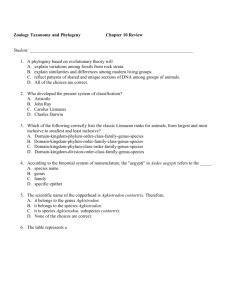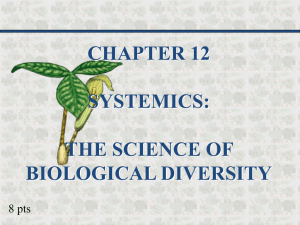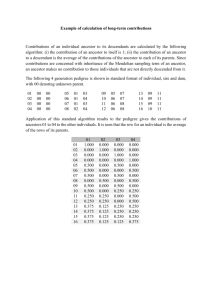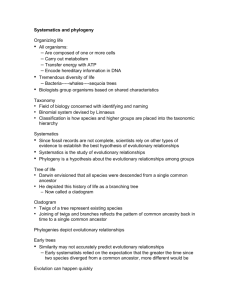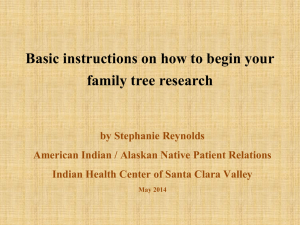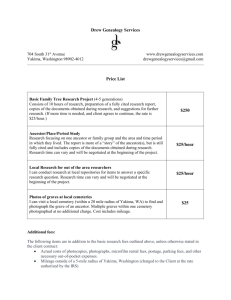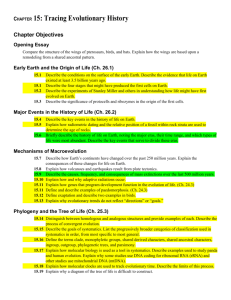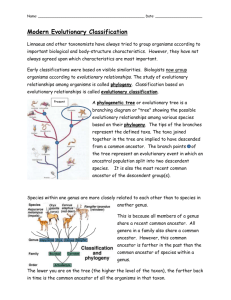Chapter 10 Review Key - Moore Public Schools
advertisement
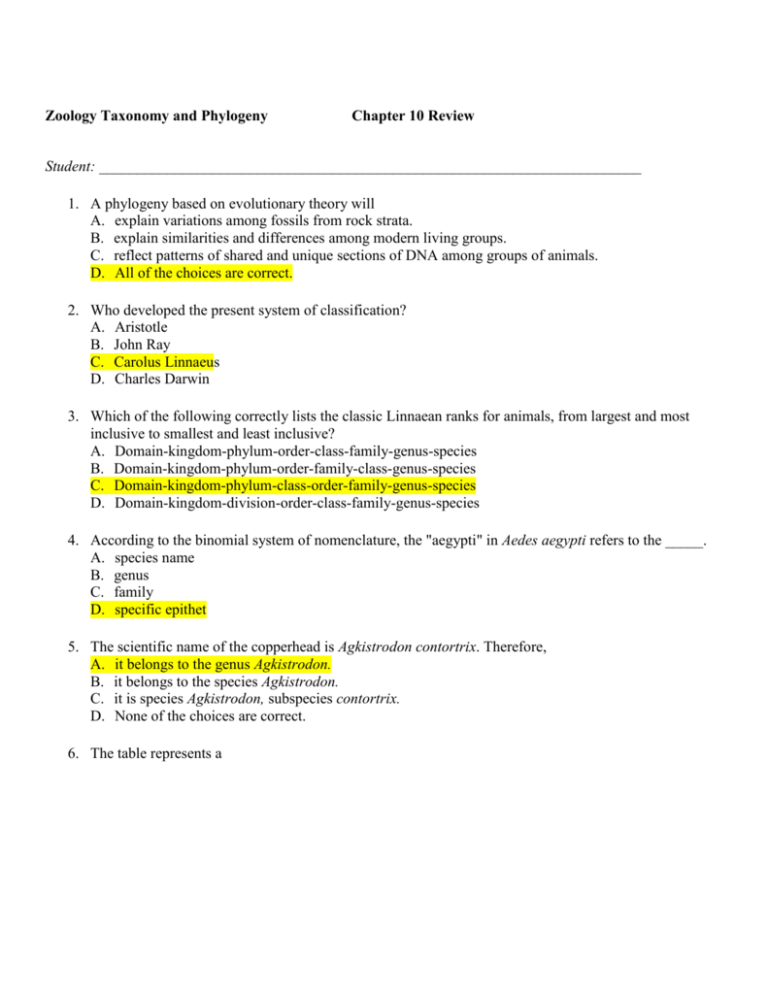
Zoology Taxonomy and Phylogeny Chapter 10 Review Student: ________________________________________________________________________ 1. A phylogeny based on evolutionary theory will A. explain variations among fossils from rock strata. B. explain similarities and differences among modern living groups. C. reflect patterns of shared and unique sections of DNA among groups of animals. D. All of the choices are correct. 2. Who developed the present system of classification? A. Aristotle B. John Ray C. Carolus Linnaeus D. Charles Darwin 3. Which of the following correctly lists the classic Linnaean ranks for animals, from largest and most inclusive to smallest and least inclusive? A. Domain-kingdom-phylum-order-class-family-genus-species B. Domain-kingdom-phylum-order-family-class-genus-species C. Domain-kingdom-phylum-class-order-family-genus-species D. Domain-kingdom-division-order-class-family-genus-species 4. According to the binomial system of nomenclature, the "aegypti" in Aedes aegypti refers to the _____. A. species name B. genus C. family D. specific epithet 5. The scientific name of the copperhead is Agkistrodon contortrix. Therefore, A. it belongs to the genus Agkistrodon. B. it belongs to the species Agkistrodon. C. it is species Agkistrodon, subspecies contortrix. D. None of the choices are correct. 6. The table represents a A. B. C. D. E. classification of the frog Rana sphenocephala. phylogenetic tree of Rana sphenocephala. cladogram of Rana sphenocephala. hierarchical list of the taxonomic ranks and taxa to which Rana sphenocephala belongs. listing of the scientific names of Rana sphenocephala. 7. What is character similarity that results from common embryology, and therefore ancestry, called? A. analogy B. taxonomy C. homology D. phylogeny 8. _______ character states are present in the common ancestor and all members of a group. A. Ancestral B. Analogous C. Derived D. Synapomorphous 9. Zoologists used to refer to animals as "simple'' and "advanced.'' Now it is more scientifically accurate to use A. "simple'' and "complex,'' since it is the complexity that evolved. B. "allopatric" and "sympatric,'' since the reproductive isolation of the species is most important. C. "evolved'' and "un-evolved,'' since everything ties together with evolution. D. "ancestral'' and "derived,'' since some early forms became very complex and some highly evolved forms are derived from them but lost complex characters and secondarily became more "simple". 10. One way of establishing whether a character of an extant species is ancestral or derived is to locate a/an ______ and if the character occurs in both, it is likely ________. A. fossil, ancestral B. fossil, derived C. sister species, derived D. outgroup, ancestral 11. Characters used to distinguish one group from another must be A. morphological or structural features. B. chromosomal or genetic. C. molecular and cellular structures. D. Any or all of the above 12. The ability to use biochemical data to form phylogenetic trees is based on the assumption that A. all life uses the same sequences of DNA. B. there are no mutations in DNA. C. amino acids are unrelated to evolution. D. protein and DNA sequences undergo similar rates of divergence through time. 13. A taxon is paraphyletic if it A. includes the most recent common ancestor of all members of the group and all of its descendants. B. includes the most recent common ancestor of all members of the group and some, but not all, of its descendants. C. does not include the most recent common ancestor of all members of the group. D. excludes the most recent common ancestor of all members of the group. 14. A taxon is monophyletic if it A. includes the most recent common ancestor of all members of the group and all of its descendants. B. includes the most recent common ancestor of all members of the group and some, but not all, of its descendants. C. does not include the most recent common ancestor of all members of the group. D. excludes the most recent common ancestor of all members of the group. 15. To a cladist, the statement that birds (a monophyletic group) evolved from reptiles (a paraphyletic group) constitutes which of the following? A. a meaningful statement of the evolutionary advancement of the birds over the reptiles B. a meaningful statement that birds represent a different, but not necessarily more advanced adaptive zone than reptiles C. a trivial statement that birds evolved from something that they are not D. an incorrect statement because ancestral groups must be extinct but reptiles are still alive 16. Two different monophyletic taxa are termed _____ if they share common ancestry with each other more recently than either one does with another taxa. A. outgroups B. sister groups C. sibling species D. paraphyletic 17. Museum type specimens are kept as "name bearers" for comparison when potentially new species are discovered. However, the original use of type specimens reflected a sense of the "ideal" or "perfect" specimen as seen in the ______ species concept. A. typological B. biological C. evolutionary D. phylogenetic 18. In the scientific name "Didelphis marsupialis Linnaeus, 1758," the section "Linnaeus, 1758" indicates that the specimen was A. named after Linnaeus who was born in 1758. B. named by Linnaeus who was born in 1758. C. named by Linnaeus and the description was published in 1758. D. named by Linnaeus and based on a specimen collected in 1758. 19. The biological species concept by Theodosius Dobzhansky and Ernst Mayr defines a species in the textbook as a group of interbreeding natural populations reproductively isolated from other such groups and occupying a specific niche. Such a definition cannot be used for A. fossils. B. asexual organisms. C. determining species based on dead or preserved specimens. D. organisms that cannot be raised in captivity, easily bred, or with very long generation times. E. All of the choices pose problems for the biological species concept. 20. An entomologist discovered that two morphologically identical crickets sang completely different mating songs and this resulted in the two populations never mating. Thus they were A. sister groups. B. sibling species. C. paraphyletic. D. polyphyletic. 21. Which of the following concepts of species is most compatible with the goals of cladistic systematics? A. typological B. biological C. evolutionary D. phenetic 22. A species of fern that was only found on one small island would be defined as A. an outgroup. B. cosmopolitan. C. speciating. D. endemic to the island. 23. The time, usually on a larger or geological time scale, that a species exists before it becomes another species or goes extinct is its A. adaptive zone. B. reproductive cohesion. C. geographic range. D. evolutionary duration. 24. Which kingdom in Whittaker's five-kingdom system must be discontinued and broken up to be compatible with cladistic systematics? A. Plantae B. Fungi C. Animalia D. Protista 25. What biochemical trait varies but is present throughout all of life, allowing the construction of an estimate of phylogeny? A. DNA in the nucleus B. DNA in mitochondria C. RNA in the nucleus D. Ribosomal RNA 26. If a taxon includes the most recent common ancestor of a group of organisms and all of the descendants of that ancestor, it is termed Monophyletic 27. If two different taxa share common ancestry with each other more recently than either one does with any other organisms, we call them sister groups 28. A derived character shared by members of a clade is a synapomorphy 29. A branching diagram representing a nested hierarchical pattern of clades is called a/an cladogram 30. A branching diagram whose branches represent real lineages that occurred in the evolutionary past is called a/an phylogentic tree 31. "A characteristic reaction and mutual relationship between environment and organism, a way of life and not a place where life is led" is the classical description of a/an adaptive zone 32. Species that have very restricted geographic distributions are called endemic_ 33. "A single lineage of ancestor-descendant populations that maintains its identity from other such lineages and which has its own evolutionary tendencies and historical fate" describes the evolutionary species concept. 34. "An irreducible (basal) grouping of organisms, diagnosably distinct from other such groupings, and within which there is a parental pattern of ancestry and descent" describes the phylogenetic species concept
